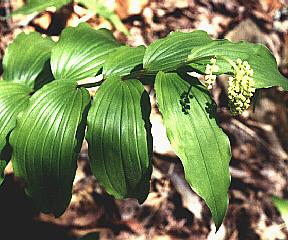
False Solomon's Seal
Smilacina racemosa
Lily Family (Liliaceae)

Blooms April to June
False Solomon's Seal, also known as False Spikenard, is a perennial that shares several characteristics with it's cousin Smooth Solomon's Seal. Although both plants possess ovate leaves arranged oppositely, the stem of False Solomon's Seal grows in a slight zigzag fashion, with the leaves displaying strong vienation. Overall, it is slightly smaller, growing one to two feet at maturity, and slightly rougher in texture. During the summer months the two are easily distinguishable by the types of flowers they produce. While Smooth Solomon's Seal has pairs of bell-shaped flowers, False Solomon's Seal displays a cluster of small white star-shaped flowers at the tip of the stem. The rhizome, a modified stem used for storage beneath the ground, lacks the stem scar present on Smooth Solomon's Seal.
The blooming period for False Solomon's Seal ranges from April to June. It finds its home in moist, rich woods and stream banks throughout much of the state, except near the coast. The fruit begins as a red berry, changing to green with fine red dots at maturity between August and October.
Traditional medicinal uses for this plant include root tea used for constipation and upset stomach, as well as leaf tea to quiet coughs and aid in contraception. The leaf tea can also be applied topically to reduce discomfort associated with itching or a rash.

NC Range of False Solomon's Seal